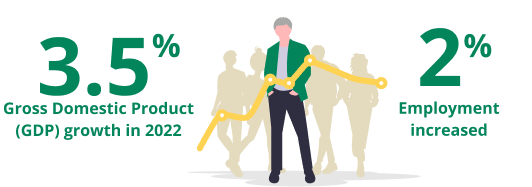Although the war in Ukraine and the ensuing energy crisis dampened growth, their impact on the EU labour market was rather muted.
A year and a half after the start of Russia’s war of aggression against Ukraine, the EU economy is faring better than initially expected. GDP growth in 2022 reached 3.5 % in both the EU and the euro area, compared with initial forecasts of respectively 2.7 % (EU) and 2.3 % (euro area) in Spring 2022.


Almost two years after the start of Russia’s war of aggression against Ukraine, the EU economy is faring better than initially expected. Gross Domestic Product (GDP) growth in 2022 reached 3.5 % in both the EU and the euro area, compared with initial forecasts of 2.7 % (EU) and 2.3 % (euro area) in spring 2022. The labour market has also proved to be particularly resilient, with continued job creation and record-low unemployment. In 2022, the unemployment rate stood at about 6 %, the lowest rate in the years for which the EU aggregate is available, while employment increased by 2 %, benefitting from a strong recovery after the pandemic recession. The job vacancy rate also reached a record high.

Wage developments in the EU are responding to the economic and labour market developments discussed in Chapter 1. Tight labour market conditions and high inflation have pushed wages up, while the uncertainty about labour market prospects and an increasing labour supply (through higher labour market participation) have had the opposite effect. This has so far resulted in record-high wage growth in nominal terms in the last two decades, but this is still below inflation. Real wages decreased by 0.8 % in the second quarter of 2023 (compared with the same quarter of 2022). At the same time, purchasing power losses of households have been mitigated by public transfers and tax reductions, leading to a slight rebound in real gross disposable income in the first quarter of 2023.

Working time has been on a long-term declining trend during the last decades in developed economies, including the EU. This trend has been driven by multiple factors, such as the reduction of the length of the working week, the increase in the share of part-time workers, and, recently, during the pandemic, the use of short-time work schemes to mitigate the economic impact of the health crisis. This chapter looks at how different groups of workers in different Member States have seen their working hours develop in recent years, and assesses what individual and societal factors have influenced these changes. Moreover, it looks at the economic evidence regarding the impacts of previous working time reductions.
Chapter 1
EU Member States have different degrees of economic vulnerability to the rise in energy prices, which reflects the structure of their economies and the relative importance of energy-intensive industries, notably manufacturing, in each Member State. This heterogeneity implies that the effect of the energy shock is asymmetric, which could ultimately lead to divergences in employment growth between Member States.
The graph shows the contribution to total employment growth by each sector groups (split by levels of energy intensity) for each country. Therefore, it captures the combined effect of the employment growth in each group on total employment. In many Member States, employment stagnated or declined in industries with high energy intensity, while it rose steadily in those with very low energy consumption. By contrast, in more than half of the Member States, industries with energy intensity close to the median experienced either a stagnation of employment (industries with mid-low energy intensity) or a decline (those with mid-high energy intensity).
Contribution to total employment growth between the fourth quarter of 2019 and the first quarter of 2023 by energy intensity of production
Chapter 2
Real wages declined by 0.8 % in the second quarter of 2023 compared with the same quarter of 2022 in the EU. Real wage losses are still observed in a majority of Member States, with the largest drops (more than 4 %) in Czechia, Italy and Malta. By contrast, some Member States already experienced a marked rebound in real wages, with an annual growth of more than 5 % in the second quarter in Belgium, Romania and Slovenia.
The decline observed in the second quarter of 2023 (-0.8 % compared to the same quarter of 2022) was far below the record fall of 5.1 % year-on-year in the EU in the third quarter of 2022. This slowdown in real wage losses is the result of increased annual nominal wage growth, combined with a downward trend in inflation since November 2022.
Real wages per employee, annual percentage change
Chapter 3
Women tend to work shorter full-time weekly hours, but slightly longer part-time weekly hours than men. Women in the EU work on average 34.7 hours, 5.2 hours less than men.
The gender gap in average weekly hours across Member States is highest in Denmark, Germany, the Netherlands and Austria and lowest in central and eastern European Member States and Greece. The gap is likely to be strongly influenced by the cross-country institutional differences such as the availability of part-time work arrangements, the access to quality early childcare and elderly care and taxation policies. The gender gap in hours worked has been gradually narrowing since 2008.
Gender gap in average weekly hours of work by Member State (2021)
Conclusion
The EU labour market has entered the economic slowdown from a very strong position.
Conclusion
Since the beginning of 2022, nominal wage growth in the EU has been robust, but still well below inflation, leading to significant losses in real terms.
Conclusion
The average weekly hours of work per worker have been steadily decreasing in the EU and in the majority of Member States since 2008.